Recurring Revenue Businesses In a Nutshell
The best recurring revenue businesses solve ongoing problems that customers face daily, such as software subscriptions (like Slack or Zoom), membership communities, subscription boxes, and service contracts that people need regularly. These businesses work because customers pay monthly or yearly for continuous value, creating predictable income that grows over time without starting from zero each month.
–
For the top 20 recurring revenue businesses (along with the quick win, hidden risk, and real-world example), jump to this section.
For the 5 criteria to spot a profitable subscription business, go here.
–
This guide walks you through 20 proven business models, reveals what makes them successful, and gives you a step-by-step blueprint to launch your own recurring revenue machine.
.
Curious what a truly creator-first checkout platform feels like in practice? You can sign up for a CartMango account for $0/month + 0% commission (totally free). Enjoy advanced features with 0 risk & discover why more creators are switching.
.

Why Recurring Revenue Matters More Than Ever in 2025
The financial world has shifted dramatically in favor of predictable income streams. When I look at the data, the story becomes crystal clear about why smart money chases recurring revenue models.
When selling a company, subscription-based businesses typically command 2-4 times higher sale prices than traditional transactional businesses (Source: Quantive). This is because buyers are willing to pay more for the predictable, recurring revenue that reduces their investment risk compared to businesses that depend on one-time purchases.
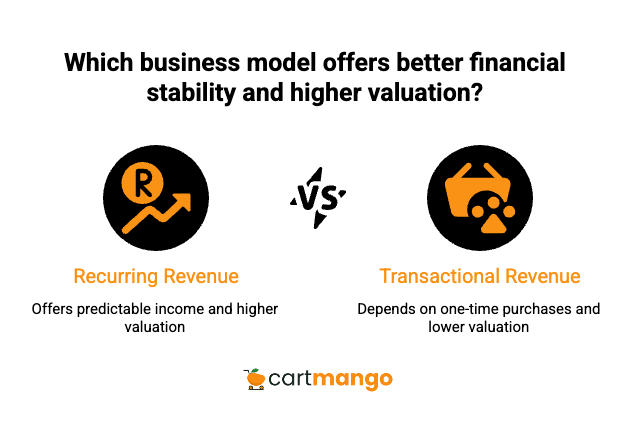
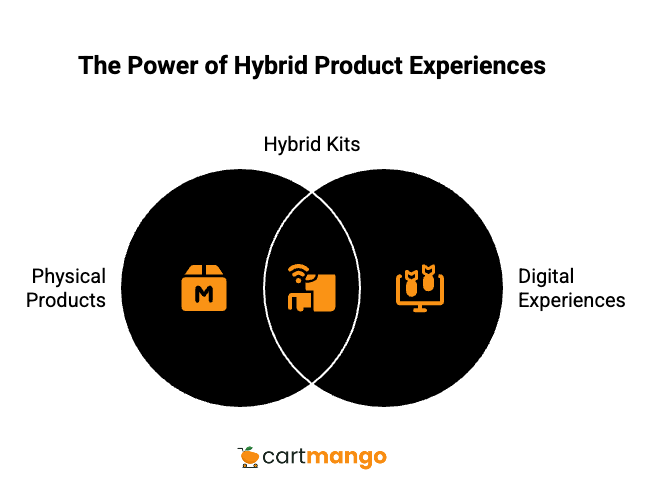
When you’re not starting from zero each month, scrambling to find new customers just to keep the lights on, you’re building on a foundation that grows stronger over time. Investors pay premium prices for this predictability because they can forecast returns with much greater accuracy.
The profit margins for digital subscription businesses tell an even more compelling story. The average gross margins hover around 70%, compared to 20-30% for most physical product businesses (Source: Finro).
What Makes a “Best” Recurring-Revenue Business?
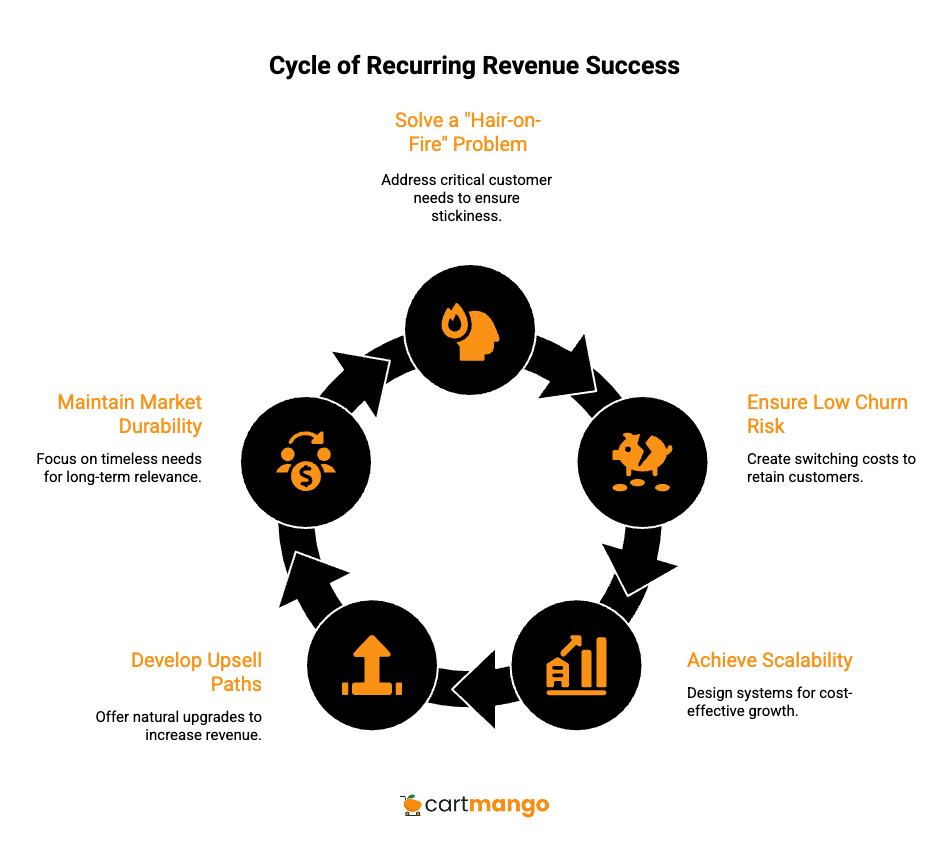
Not every subscription model succeeds. I’ve watched countless entrepreneurs chase the recurring revenue dream only to see their monthly numbers bleed away through churn. The difference between winners and losers comes down to 5 core criteria:
Criterion | Why It Counts | Practical Tip |
|---|---|---|
Solves a “hair-on-fire” problem | Drives stickiness and referrals | Conduct 15 discovery interviews before building |
Low churn risk | Prevents revenue leakage | Add milestone-based loyalty rewards |
Scalability | Revenue outpaces cost curve | Automate fulfillment and support early |
Upsell paths | Expands account value over time | Layer tiered pricing and add-on bundles |
Market durability | Resists fads and downturns | Validate 5-year CAGR via industry reports |
The “hair-on-fire” test matters most
Your customers need to feel genuine pain when your solution disappears. Think about what happens when Netflix goes down during your favorite show, or when your project management tool crashes right before a deadline. That’s the level of dependency you want to create.
This isn’t about creating artificial addiction. It’s about solving problems so fundamental that your absence creates immediate workflow disruption. Email marketing tools like ConvertKit succeed because removing them would break customer communication systems. Photo storage services work because losing family photos would be devastating.
Low churn risk isn’t just about product quality
It’s about creating switching costs that make leaving painful. Maybe you’ve built integrations that would take weeks to replicate elsewhere. Perhaps your community has become central to how customers learn and network. The best recurring revenue businesses make themselves harder to leave than to keep.
Consider how Slack achieves low churn. The product quality matters, but the real lock-in comes from chat history, custom integrations, and team workflows that would be expensive to recreate. Switching to Microsoft Teams isn’t just about learning new software. It’s about rebuilding an entire communication ecosystem.
Scalability means your costs don’t grow linearly with revenue
Software scales beautifully because serving customer number 1,000 costs roughly the same as serving customer number 10. Physical products require more creativity, but smart operators find ways to batch fulfillment, automate support, and create systems that handle growth without proportional cost increases.
The key insight here is designing for scale from day one.
- Don’t build manual processes that will break at 100 customers.
- Don’t create support systems that require human intervention for every question.
- Think about how your business will operate at 10× current size, then build those systems today.
Upsell opportunities separate good recurring businesses from great ones
Your initial offer gets customers in the door, but account expansion drives the real profit. Design your pricing tiers and add-on products from day one, not as an afterthought when growth slows.
.
Making it simple for your customers to subscribe? Create flexible subscriptions and pricing plans in CartMango. Seamlessly tailor recurring options for any product or service – see it live before you commit. Grab your account for $0/month + 0% commission (totally free).
.
The most successful recurring revenue business model creates natural upgrade paths. Basic users hit limits that premium plans solve. Single users need team features. Small teams need enterprise security. Each upgrade should feel like a natural progression, not a sales pitch.
Market durability protects your investment over time.
Trends come and go, but fundamental human needs endure. Focus on business models that solve timeless problems rather than riding temporary waves that might crash without warning.
Ask yourself: will people still need this solution in 10 years?
Communication, productivity, health, education, and security needs don’t disappear. But specific technologies and approaches evolve constantly. Build on bedrock, not shifting sand.
20 Profitable Recurring Revenue Business Ideas for 2025
Here are the models I’ve seen work consistently, along with their hidden risks and real-world examples:
# | Model | Quick Win | Hidden Risk | Real-World Example |
|---|---|---|---|---|
1 | Vertical-niche SaaS | One pain-killer feature | Feature creep | LawyerReferralSource for law firm intake |
2 | Membership communities | Access plus accountability | Content fatigue | Precision Nutrition’s coaching certification |
3 | Subscription boxes (physical-only) | Predictable inventory cycles | Rising shipping costs | Dollar Shave Club’s grooming essentials |
4 | Hybrid physical plus digital kits | Product plus live sessions | Scheduling complexity | The Sill’s plant care plus expert guidance |
5 | Home-service contracts | Local, sticky demand | Labor shortages | Molly Maid’s recurring cleaning plans |
6 | Course libraries | Evergreen lessons | Low completion rates | LinkedIn Learning’s skill development |
7 | AI usage-based tools | Pay-as-you-grow billing | Bill shock | RunwayML’s text-to-video generator |
8 | Maintenance and repair plans | Built-in lock-in | Seasonality | Carrier’s annual HVAC tune-up packages |
9 | Licensing and royalties | Mostly passive after setup | Contract complexity | Splice’s music sample marketplace |
10 | Equipment and fashion rental | Eco appeal | Inventory wear | Rent the Runway’s designer clothing |
11 | Coaching on retainer | High-margin expertise | Founder bandwidth | Strategic Coach’s business advisory |
12 | Managed cybersecurity (MSSP) | 24/7 SOC monitoring | Talent shortage | Arctic Wolf’s security operations |
13 | Data and API subscriptions | No UI, just endpoints | Data freshness | PriceSpider’s real-time pricing feeds |
14 | Premium newsletter and research | Fast Substack launch | Content drumbeat | Morning Brew’s business intelligence |
15 | Smart-home monitoring | Hardware plus app fees | Device returns | SimpliSafe’s security system monitoring |
16 | Coworking memberships | Monetize fixed capacity | Real-estate overhead | WeWork’s flexible workspace access |
17 | Unlimited car-wash club | High visit frequency | Water-usage costs | Moo Moo Express Car Wash memberships |
18 | Pet wellness plans | Year-round vet care | Low-margin medications | Banfield Pet Hospital’s preventive plans |
19 | WordPress care and hosting | Recurring upkeep | Plugin conflicts | WP Engine’s managed hosting platform |
20 | Connected fitness hardware plus content | Equipment lock-in | Hardware breakage | Peloton’s bike plus class subscriptions |
1/ Vertical-Niche SaaS
This strategy wins because you solve specific workflow problems that generic tools miss. Instead of building for everyone, you focus on one industry’s unique needs. A dental practice management system can charge premium prices because it handles appointment scheduling for different procedures, tracks patient histories, and manages insurance claims.
The narrow focus means less competition and customers who desperately need your exact solution. Feature creep kills focus, so resist adding capabilities that dilute your core value. Success comes from understanding industry workflows better than generalist competitors who try to serve everyone.
2/ Membership Communities
The magic happens when you combine information access with peer accountability. People can find knowledge anywhere online, but they struggle to apply it consistently. Your community provides structured learning paths, progress tracking, and peer support that keeps members engaged month after month.
Think cooking classes where members share photos of their attempts and get feedback from instructors. Content fatigue is real – you need fresh challenges and member spotlights to maintain energy over time. The key is creating genuine connections between members, not just access to information.
3/ Subscription Boxes (Physical-Only)
This model works by eliminating decision fatigue around routine purchases. Customers pay monthly for curated products delivered automatically. You handle sourcing, quality control, and shipping logistics while they enjoy surprise discoveries. The key is finding products with high perceived value but reasonable wholesale costs.
Shipping expenses eat profits quickly, especially for heavy items. Success requires negotiating volume discounts and optimizing packaging to reduce dimensional weight charges that kill margins. Smart operators focus on lightweight, high-value products that create excitement without destroying unit economics.
4/ Hybrid Physical + Digital Kits
You’re blending tangible products with digital experiences that reinforce each other. A monthly tea subscription might include physical samples plus virtual tastings with expert guides. The physical component creates immediate satisfaction while digital elements build long-term engagement and community connections.
Scheduling complexity multiplies when you coordinate physical deliveries with live sessions across time zones. Smart operators batch shipments around digital events and use automation to manage the coordination without manual intervention. Success requires seamless integration between physical and digital components.
5/ Home-Service Contracts
Customers want consistent service without the hassle of scheduling and managing providers. They pay premium prices for reliable dates and trusted staff who understand their preferences. The recurring model works because home maintenance is ongoing, not one-time, creating natural subscription opportunities.
Labor shortages create real challenges, but companies investing in employee retention through better compensation maintain competitive advantages. Your advantage comes from systematized training and quality control that ensures consistent experiences. Success requires building operational systems that deliver reliability regardless of individual staff turnover.
6/ Course Libraries
This strategy succeeds when you provide comprehensive learning systems rather than isolated courses. Professionals need continuous skill development as industries evolve rapidly. The subscription model works because knowledge becomes outdated quickly, requiring regular updates and fresh content.
Low completion rates are normal – customers buy access to expertise, not necessarily full course completion. Your value comes from organizing content into learning paths and updating materials regularly to reflect industry changes. Success requires balancing depth with breadth across your target audience’s learning needs.
7/ AI Usage-Based Tools
This pricing model aligns costs with customer value by charging based on actual usage rather than fixed monthly fees. A text-to-video tool might charge per minute of content generated. Customers appreciate paying only for what they use, especially when needs fluctuate seasonally or project-based.
Bill shock becomes a real concern when usage spikes unexpectedly. Build spending alerts, usage dashboards, and automatic caps that protect customers from surprise charges while maintaining their trust. Success requires transparent pricing that feels fair even when usage varies dramatically month to month.
8/ Maintenance and Repair Plans
Equipment failure is expensive and unpredictable, making preventive maintenance valuable. Customers pay monthly for regular servicing that prevents costly breakdowns. The model works because small problems become big expenses when ignored, creating clear value propositions.
Seasonal demand creates cash flow challenges for heating and cooling services. Smart operators balance different service types across climate zones or expand into complementary services that smooth revenue patterns throughout the year. Success requires building trust through consistent quality and proactive problem prevention.
9/ Licensing and Royalties
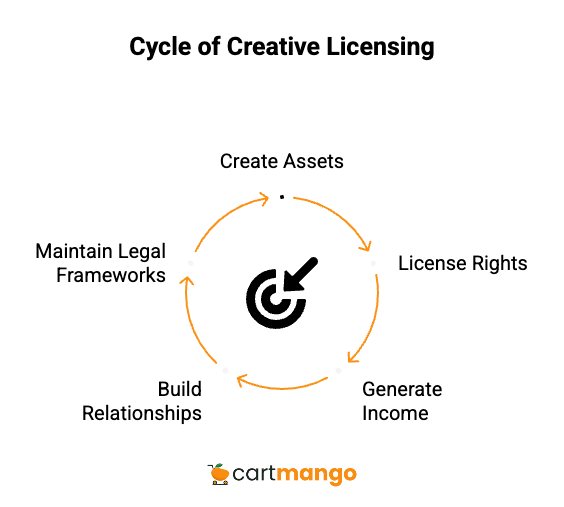
You’re turning creative assets into recurring income streams by licensing usage rights. Music producers might pay monthly for unlimited access to professionally recorded samples. The model works because creative professionals need constant inspiration and fresh content to stay competitive.
Contract complexity is the hidden challenge – you’re managing intellectual property rights, usage restrictions, and creator compensation. Success requires building relationships with content creators and maintaining legal frameworks that protect everyone involved. Clear terms prevent disputes and enable sustainable growth.
10/ Equipment and Fashion Rental
This taps into the psychology of wanting access without ownership. Customers pay monthly for rotating access to expensive items they use occasionally. The model works because purchasing high-end equipment or designer clothes for infrequent use feels wasteful to many consumers.
Inventory wear is your biggest challenge – items lose value through normal use. Factor replacement costs into pricing and create tier systems that reflect item condition and desirability. Success requires balancing inventory investment with rental revenue while maintaining quality standards that justify premium pricing.
11/ Coaching on Retainer
This model packages expertise into ongoing relationships rather than one-time consulting sessions. Business problems are continuous, not discrete, making regular guidance valuable. Clients pay monthly for access to your knowledge and accountability, creating predictable revenue streams.
Your personal bandwidth becomes the limiting factor – you can’t scale yourself infinitely. Success comes from creating frameworks, group programs, and systems that deliver value without requiring constant individual attention for every client. Smart coaches build leverage through repeatable processes and community elements.
12/ Managed Cybersecurity (MSSP)
Small businesses want enterprise-level security without the complexity of managing it internally. They pay monthly for 24/7 monitoring, threat detection, and incident response. The model works because cyber threats are constant and evolving, requiring specialized expertise most companies can’t afford internally.
Talent shortage creates real challenges – security engineers command high salaries at tech companies. Success requires creative retention strategies like remote work flexibility, profit sharing, and professional development opportunities that compete with larger employers. Building automated systems reduces dependence on individual experts.
13/ Data and API Subscriptions
You’re providing real-time information feeds that businesses integrate into their operations. E-commerce companies might pay monthly for pricing data that keeps them competitive. The model works because current information is valuable and time-sensitive in fast-moving markets.
Data freshness becomes critical – outdated information is worthless. Your customers integrate your feeds into their systems, creating switching costs that improve retention. Maintaining data quality and uptime is essential because API failures stop customer businesses from functioning properly.
14/ Premium Newsletter and Research
This strategy works by filtering information overload into actionable insights. Busy executives pay for summarized intelligence that saves time and provides competitive advantages. The model succeeds because raw information is abundant but synthesized insights are rare and valuable.
Content drumbeat means you’re always working on the next edition. Success comes from developing unique perspectives, reliable sources, and consistent quality that justifies subscription fees over free alternatives. Building a reputation for accuracy and relevance drives long-term subscriber loyalty.
15/ Smart-Home Monitoring
You’re combining hardware sales with ongoing monitoring services. Customers buy security systems but pay recurring fees for professional monitoring and emergency response. The model works because peace of mind has ongoing value that justifies monthly payments.
Device returns hurt profitability – customers who cancel subscriptions often return hardware too. Success requires balancing hardware subsidies with monitoring revenue to achieve acceptable unit economics while maintaining service quality. Smart operators focus on sticky services that create long-term value.
16/ Coworking Memberships
This model monetizes fixed real estate costs through flexible memberships. Professionals pay monthly for workspace access without long-term lease commitments. The strategy works because remote work is permanent but home offices have limitations for productivity and networking.
Real estate overhead is your biggest risk – you’re committed to lease payments regardless of membership levels. Success requires designing spaces that accommodate different work styles and building communities that justify premium pricing. Creating networking opportunities and exclusive events increases member retention.
17/ Unlimited Car-Wash Club
Customers prefer unlimited access to usage-based pricing for routine services. Members pay monthly for unlimited car washes rather than per-visit fees. The model works because car washing is habitual and weather-dependent, creating predictable demand patterns.
Higher usage frequencies increase water and chemical costs. Smart operators balance membership pricing with average usage patterns and invest in water recycling systems to control variable costs while maintaining service quality. Success requires managing capacity during peak demand periods.
18/ Pet Wellness Plans
This transforms veterinary care through subscription wellness plans. Pet owners pay monthly for preventive care, vaccinations, and routine treatments. The model works because pet health is emotional and ongoing, with owners willing to pay premium prices for peace of mind.
Low-margin medications are often included but subsidized by higher-margin services. Success requires balancing comprehensive care with cost control while building emotional connections with pet owners who view their animals as family members. Preventive care reduces expensive emergency visits.
19/ WordPress Care and Hosting
This solves the complexity of website maintenance for business owners. Customers pay monthly for hosting, security updates, and technical support. The model works because websites require ongoing attention that most business owners can’t provide themselves effectively.
Plugin conflicts create service challenges – you’re managing software you didn’t write. Success comes from proactive monitoring, automated backup systems, and rapid response to security threats. Building expertise in WordPress ecosystems creates competitive advantages that justify premium pricing.
20/ Connected Fitness Hardware + Content
You’re combining equipment sales with content subscriptions for home fitness. Customers buy exercise equipment but pay monthly for live and on-demand fitness classes. The model works because home fitness requires motivation and variety that equipment alone can’t provide.
Hardware breakage creates warranty costs and customer frustration. Success requires balancing equipment quality with content production costs while building instructor personalities that create emotional connections. Smart operators focus on durable equipment and engaging content that drives long-term retention.
Challenges (and how to fix them)
Every recurring revenue business faces predictable obstacles. Here’s how successful operators handle the big four challenges:
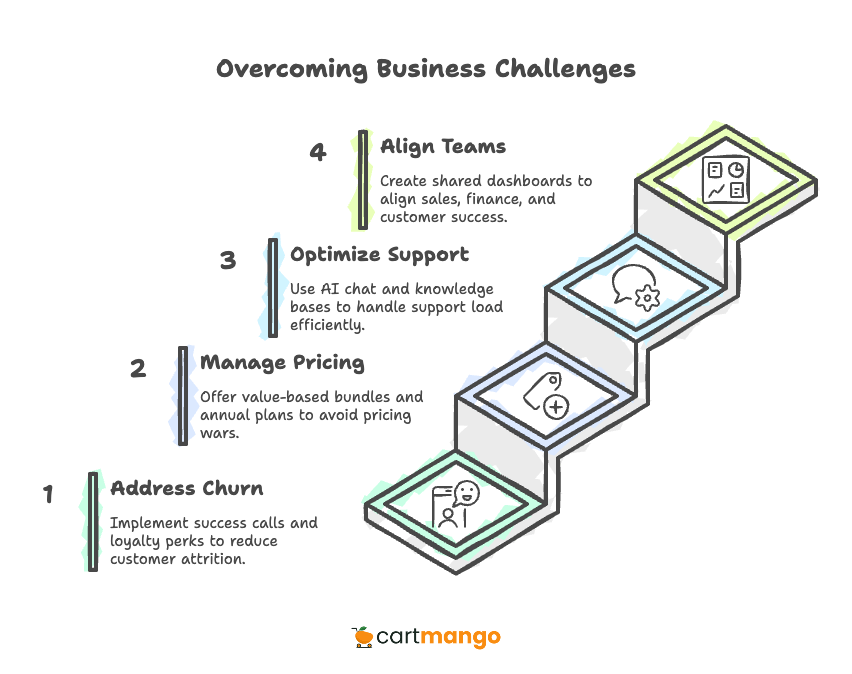
Pain Point | Why It Hurts | Proven Fix |
|---|---|---|
Churn | Shrinks MRR and kills growth momentum | “Day-14” success call plus loyalty perks |
Pricing wars | Race to bottom destroys margins | Value-based bundles plus annual plans |
Support load | 24/7 expectations drain resources | AI chat plus self-serve knowledge base |
Renewal silos | Finance vs Sales misalignment | Shared KPI dashboard (MRR, NRR) |
Churn
Churn is the silent killer that destroys otherwise promising businesses. The day-14 success call isn’t about selling more features. It’s about ensuring customers achieve their first meaningful win with your product. Follow up with milestone-based rewards that celebrate progress and build emotional investment.
Consider this:
A project management SaaS loses 12% of customers monthly. They were obsessed with acquisition metrics but ignored onboarding experience. Customers signed up excited but churned within 30 days because they couldn’t figure out basic workflows.
The fix was simple but required discipline. Every new customer got a personal onboarding call within 48 hours. The goal wasn’t selling upgrades but ensuring they completed their first project successfully. This single change cut churn from 12% to 5% within three months.
Pricing Wars
Pricing pressure intensifies as markets mature and competition increases. The natural reaction is lowering prices to match competitors, but this creates a race to the bottom that destroys margins. The better approach is value-based bundling that makes price comparisons difficult.
Instead of competing on individual features, create packages that solve complete workflows. A basic email marketing tool might cost $29/month, but a complete “creator growth system” including email, landing pages, automation, and analytics can command $79/month for the same underlying functionality.
Annual plans help too. Offering 2-3 months free for annual commitments improves cash flow while reducing churn. Customers who pay annually are psychologically committed to using your product for the full term.
Support Load
Support load can quickly overwhelm small teams as you scale. The temptation is hiring more support staff, but this creates linear cost scaling that destroys unit economics. The smart approach is channeling common questions into self-service resources while reserving human support for complex issues.
Start by analyzing your support tickets to identify the most common questions. These become knowledge base articles, video tutorials, and automated email responses. AI chat can handle basic questions and route complex issues to human agents.
The goal isn’t eliminating human support but making it more efficient. When customers can solve 60% of problems independently, your support team can focus on the 40% that require expertise and personal attention.
Renewal Silos
This can happen when different teams own pieces of the customer lifecycle without coordination. Sales celebrates new customer acquisitions while Finance tracks payment failures and Customer Success manages product usage. Without shared visibility, opportunities fall through the cracks.
The solution is shared dashboards that everyone monitors. Sales should see payment failure rates for accounts they closed. Finance should understand usage patterns that predict renewal risk. Customer Success should know which accounts are expansion opportunities.
This is about creating shared incentives that align team goals. When Sales gets credit for 12-month revenue retention, not just new logos, behavior changes quickly.
Launch Checklist
- 20+ customer interviews completed with documented pain points
- Technical foundation built and tested with beta users
- MVP developed with core features that solve the main problem
- Pricing strategy validated through customer research
- Onboarding and retention systems designed and implemented
- Analytics and reporting systems tracking key metrics
- First 10 paying customers acquired and retained
- Feedback systems in place for continuous improvement
- Financial projections based on actual data, not hopes
- Growth strategy focused on one proven acquisition channel
Building Customer Loyalty and Retention Systems
Customer retention determines whether your recurring revenue product succeeds or fails. The relationship between customer satisfaction and lifetime value creates a compounding effect that separates winning businesses from struggling ones.
Loyal customers become your growth engine through referrals, testimonials, and account expansion. When you enhance customer relationships through consistent value delivery, increased customer lifetime value follows naturally. This happens because satisfied customers stay longer, buy more, and refer others to your business.
Exceptional customer support is required for meeting customer expectations. Your existing customers generate more profit than new acquisitions, making retention investments highly profitable. Premium technical support might cost more initially, but the customer lifetime value improvements justify the expense through reduced churn and increased renewals.
The recurring basis of your business requires different thinking about customer relationships. Instead of one-time transactions, you’re building long-term partnerships that evolve over time. This shift demands ongoing customer engagement strategies that maintain value delivery month after month, year after year.
Types of Recurring Revenue Across Industries
The diversity of subscription or membership models spans virtually every industry, each with unique characteristics and success factors. Understanding these variations helps you choose the right approach for your market.
We’ve talked about this earlier.
Software as a service represents the gold standard for recurring revenue models. SaaS companies achieve high margins through digital delivery, while SaaS businesses scale efficiently through automated systems. Health and fitness apps demonstrate how mobile app subscription models work in consumer markets, combining convenience with personalized experiences.
Online courses and membership site models succeed by packaging expertise into accessible formats. Personal wellness services create recurring relationships around ongoing health needs, while financial planning services build long-term client relationships through continuous advisory support. Each model requires different retention strategies but shares common success principles.
Maintenance services and marketing services prove that traditional industries can adopt recurring approaches. A monthly subscription box transforms physical products into recurring experiences, while marketing services create ongoing client relationships instead of project-based engagements. The key is identifying which types of recurring revenue fit your industry’s natural patterns.
Marketing Strategies for Sustainable Growth
Marketing costs behave differently in recurring revenue models, requiring strategies that optimize for lifetime value rather than immediate returns. Your marketing strategies must balance acquisition costs with long-term customer value.
Customer acquisition becomes an investment when you earn recurring revenue over extended periods. A customer worth $1,200 annually justifies higher marketing costs than one-time purchasers. This changes how you think about advertising spend, content marketing, and partnership development.
The predictable income generated by existing customers funds growth initiatives that traditional businesses can’t afford. When you know monthly recurring revenue from current customers, you can invest confidently in expanding your reach. This creates a growth flywheel where recurring revenue funds acquisition, which generates more recurring revenue.
Focus on channels that attract the right customers rather than the most customers. Quality matters more than quantity when building a consistent income stream. Your marketing should emphasize the ongoing value and relationship benefits that justify monthly commitments, not just initial purchase decisions.
This creates sustainable business growth that doesn’t depend on constantly finding new customers to replace churning ones. The most successful businesses achieve business growth through both new acquisition and existing customer expansion, creating multiple revenue streams from the same customer base.
TL;DR
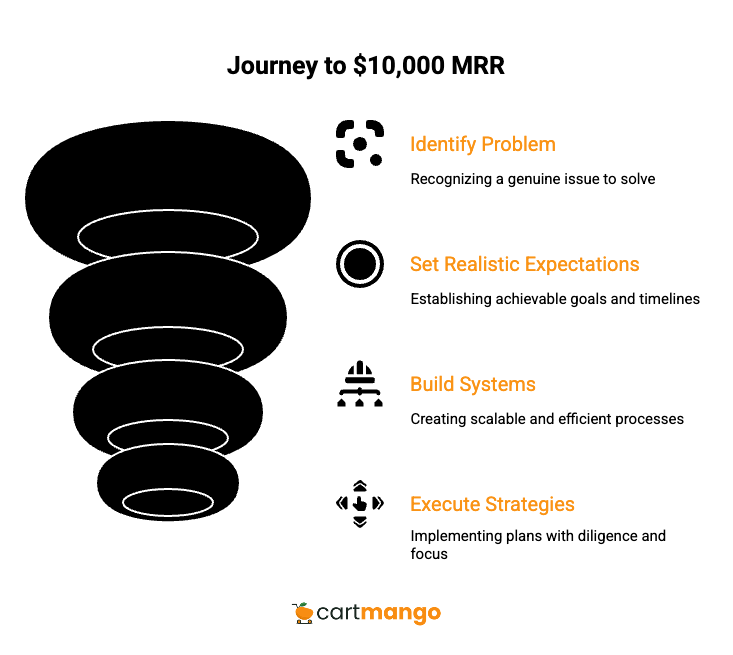
Many subscription-based businesses take 2-3 years on average to reach $10,000 MRR, which is longer than many founders initially expect (Source: ChartMogul).
But it doesn’t mean it’s impossible. It just takes time, hard work, and patience.
Recurring revenue isn’t about finding the perfect business model overnight. It’s about picking a genuine problem you can solve, launching with realistic expectations, and building systems that compound over time.
The opportunity is real and growing. Economic uncertainty makes predictable income streams more valuable. The infrastructure for launching recurring revenue businesses has never been more accessible.
The strategies in this guide provide your roadmap, but execution makes the difference between success and failure.
Turn insight into action: sign up for a CartMango account free & launch your recurring revenue product today. You can access everything at no cost whatsoever.
Related
- SendOwl vs SamCart: The Recurring Revenue Jail (2026)
- ThriveCart vs ClickFunnels: When more features hurt (2026)
- SendOwl vs Payhip: The “You-Leave-You-Lose” Model (2026)
- SamCart vs Kajabi: The Income Hostage Trap (2026)
- Sellfy vs Payhip: The Recurring Revenue Prison (2026)
- Podia vs Gumroad: The Recurring Revenue Handcuffs (2026)
- SendOwl vs Gumroad: The Recurring Revenue Black Hole (2026)
- Gumroad vs Sellfy: The Vendor Lock-in Cage (2026)
- Gumroad vs Payhip: The Hidden Trap for Creators (2026)
- ThriveCart vs SamCart – The Subscription Hostage Trap (2026)
